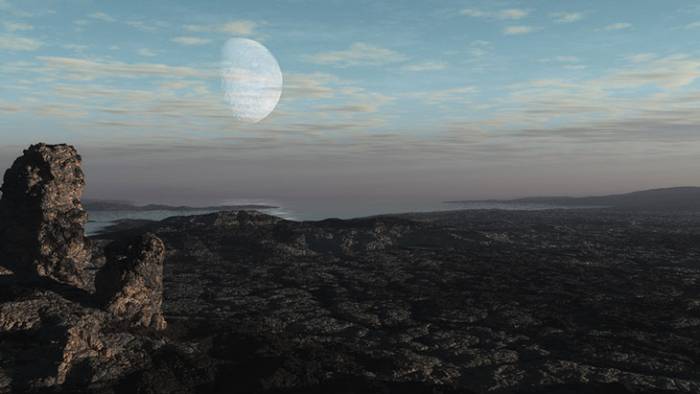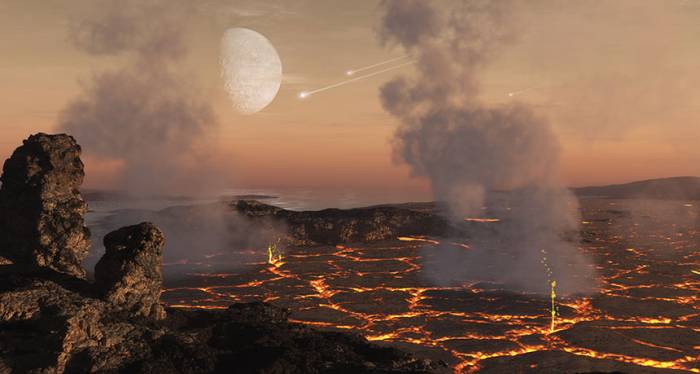Asteroid strikes repeatedly bombarded the planet during its first eon, but the heat released by those hits wasn’t as sterilizing as once thought, new research suggests. Simulations indicate that after the first few hundred million years of bombardment, the heat from the impacts had dissipated enough that 10 to 75 percent of the top kilometer of the subsurface was habitable for mesophiles — microbes that live in temperatures of 20° to 50° Celsius. If so, the planet may have been habitable much earlier than previously believed.
Earth’s earliest eon, the Hadean, spans the period from about 4.6 billion years ago, when the planet was born, to 4 billion years ago. The name, for the Greek god of the underworld, reflects the original conception of the age: dark and hellish and inhospitable to life. But little direct evidence of Hadean asteroid impacts still exists, limiting scientists’ understanding of how those collisions affected the planet’s habitability.
“There has been an assumption that the Hadean was mostly an uninteresting slag heap until the sky stopped falling and life could take hold,” says Stephen Mojzsis, a geologist at the University of Colorado Boulder. That’s not to say that all of the Hadean was pleasant; the first 150 million years of Earth’s history, which included the giant whack that formed the moon, were pretty dramatic. But after that, things settled down considerably, says Mojzsis, who was not an author of the new study.
For example, scientists have found signs of liquid water and even faint hints of possible life in zircon crystals dating back 4.1 billion years (SN: 12/28/15, p. 16). Other researchers have contested the idea that Earth was continually bombarded by asteroids through much of the Hadean, or that a last barrage of asteroids shelled the planet 3.9 billion years ago in what has been called the Late Heavy Bombardment, killing any incipient life.

In the new study, geophysicist Robert Grimm and planetary scientist Simone Marchi, both of the Southwest Research Institute in Boulder, Colo., estimated how hot it would have been just a few kilometers beneath the planet’s surface during the Hadean. The scientists used an estimated rate of asteroid bombardment, as well as how much heat the projectiles would have added to the subsurface and how much that heat would have dissipated over time to simulate how hot it got — and whether microbial life could have withstood those conditions. The research built on earlier work, including Marchi’s 2014 finding that asteroid impacts became smaller and less frequent with time (SN: 8/23/14, p. 13).
Asteroid impacts did heat the subsurface, according to the simulations, but even the heaviest bombardment scenarios were not intense enough to sterilize the planet, the researchers report March 1 in Earth and Planetary Science Letters. And if the rate of bombardment did decrease as the eon progressed, the heat the asteroids delivered to Earth’s subsurface would also have had time to dissipate. As a result, that habitable zone would have increased over time.
A Late Heavy Bombardment, if it occurred, would have been tougher for the microbes, because the heat wouldn’t have had time to dissipate with such a rapid barrage. But that just would have meant the habitable zone didn’t increase, the team reports; mesophiles could still have inhabited at least 20 percent of the top kilometer of subsurface.
Mojzsis says he’s come to similar conclusions in his own work. “For a long time people said, with absolutely no data, that there could be no biosphere before 3.9 billion years ago,” he says. But “after the solar system settled down, the biosphere could have started on Earth 4.4 billion years ago.”
That’s not to say that there was definitely life, Grimm notes. Although the heat from impacts may not have been a limiting factor for life, asteroid bombardment introduced numerous other challenges, affecting the climate, surface or even convection of the mantle. Still, the picture of Earth’s earliest days is undergoing a sea change. As Grimm says, “An average day in the Hadean did not spell doom.”
Read the original article on sciencenews.org.
More about: science
















































